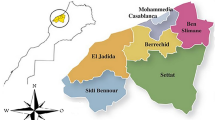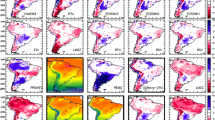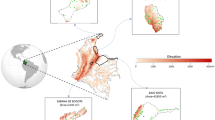Abstract
An appraisal of the recent changes in the present climate (1970–2005) followed by the possible future (2006–2100) changes in the climate has been carried out in the current study using the observations and regional climate model (REMO) over the Northeast Indian region. The regional climate model simulation has been used from the COordinated Regional climate Downscaling EXperiment (CORDEX) South Asia framework. A consistent warming for the winter (December, January, and February (DJF)) and post-monsoon (October and November (ON)) has been observed for the present climate especially in the northern and eastern parts of the region. The changes in the near future (2020–2049) and far future (2070–2099) temperature climatology suggest a rise in temperature by ~ 3–8 °C across different representative concentration pathways (RCPs). The rate of long-term (1970–2099) increase in temperature has been found ranging between 0.01 and 0.07 °C/year across the region in the least emission (RCP2.6) to strongest emission (RCP8.5) scenarios. The daily mean precipitation statistics suggests an overall increasing trends of precipitation during the pre-monsoon (March, April, and May (MAM)) for the present across the region with a mixed trend in other seasons. A change in daily mean precipitation ranging from − 60% (during winter) to + 40% during post-monsoon has been projected by the model across different RCPs. RCP4.5 and RCP8.5 show a strong deficit in precipitation in the warmer climate across the region as compared to RCP2.6. This fact is also confirmed from the long-term trend of precipitation where a consistent decreasing trend dominates in the RCP4.5- and RCP8.5-simulated precipitations by the end of the twenty-first century. A large model bias in temperature and precipitation along with high amount of uncertainty is associated with the model simulations; thus, in order to use the projections, a more careful approach to improve the utility of downscaled product should be adopted.















Similar content being viewed by others
References
Barthakur M (2004) Weather and climate. In The Brahmaputra Basin Water Resources (pp. 17-23). Springer Netherlands
Bhaskaran B, Mitchell JFB, Lavery JR, Lal M (1995) Climatic response of the Indian subcontinent to doubled CO2 concentrations. Int J Climatol 15(8):873–892
Bhaskaran B, Jones RG, Murphy JM, Noguer M (1996) Simulations of the Indian summer monsoon using a nested regional climate model: domain size experiments. Clim Dyn 12(9):573–587
Chaturvedi RK, Joshi J, Jayaraman M, Bala G, Ravindranath NH (2012) Multi-model climate change projections for India under representative concentration pathways. Curr Sci 103(7):791–802
Choudhary A, Dimri AP, Maharana P (2017) Assessment of CORDEX-SA experiments in representing precipitation climatology of summer monsoon over India. Theor Appl Climatol, 1–25
Das A, Ghosh PK, Choudhury BU, Patel DP, Munda GC, Ngachan SV, Chowdhury P (2009) Climate change in North East India: recent facts and events–worry for agricultural management. In Proceedings of the Workshop on Impact of Climate Change on Agriculture (pp. 32–37)
Dash SK, Shekhar MS, Singh GP (2006) Simulation of Indian summer monsoon circulation and rainfall using RegCM3. Theor Appl Climatol 86(1–4):161–172
Dash SK, Jenamani RK, Kalsi SR, Panda SK (2007) Some evidence of climate change in twentieth-century India. Clim Chang 85(3–4):299–321
Dash SK, Sharma N, Pattnayak KC, Gao XJ, Shi Y (2012) Temperature and precipitation changes in the north-east India and their future projections. Glob Planet Chang 98:31–44
Dimri AP (2012) Uncertainties in regional climate model simulations of Indian winter monsoon over the Western Himalayas. In AGU Fall Meeting Abstracts
Dobler A, Ahrens B (2010) Analysis of the Indian summer monsoon system in the regional climate model COSMO-CLM. J Geophys Res: Atmos, 115(D16).
Fernández J, Fita L, García-Díez M, Gutiérrez JM (2010) WRF sensitivity simulations on the CORDEX African domain. In EGU General Assembly Conference Abstracts (Vol. 12, p. 9701).
Giorgi F, Mearns LO (1999) Introduction to special section: regional climate modeling revisited. J Geophys Res: Atmos 104(D6):6335–6352
Goswami BN, Venugopal V, Sengupta D, Madhusoodanan MS, Xavier PK (2006) Increasing trend of extreme rain events over India in a warming environment. Science 314(5804):1442–1445
Guhathakurta P, Rajeevan M (2008) Trends in the rainfall pattern over India. Int J Climatol 28(11):1453–1470
Guhathakurta P, Sreejith OP, Menon PA (2011) Impact of climate change on extreme rainfall events and flood risk in India. J Earth Syst Sci 120(3):359–373
Harris, I., Jones, P. D., Osborn, T. J., & Lister, D. H. (2014). CRU TS3. 22: climatic research unit (CRU) time-series (TS) version 3.22 of high resolution gridded data of month-by-month variation in climate (Jan. 1901–Dec. 2013). NCAS British Atmospheric Data Centre, 24 September 2014. Doi: 10.5285. NCAS British Atmospheric Data Centre, 24.
Hingane LS, Rupa Kumar K, Ramana Murty BV (1985) Long-term trends of surface air temperature in India. J Climatol 5(5):521–528
Hirakuchi H, Giorgi F (1995) Multiyear present-day and 2× CO2 simulations of monsoon climate over eastern Asia and Japan with a regional climate model nested in a general circulation model. J Geophys Res: Atmos 100(D10):21105–21125
Jacob D (2001) A note to the simulation of the annual and inter-annual variability of the water budget over the Baltic Sea drainage basin. Meteorol Atmos Physics 77(1–4):61–73
Jacob D, Podzun R (1997) Sensitivity studies with the regional climate model REMO. Meteorog Atmos Phys 63(1):119–129
Jacob D, Elizalde A, Haensler A, Hagemann S, Kumar P, Podzun R et al (2012) Assessing the transferability of the regional climate model REMO to different coordinated regional climate downscaling experiment (CORDEX) regions. Atmosphere 3(1):181–199
Jain SK, Kumar V (2012) Trend analysis of rainfall and temperature data for India. Curr Sci (Bangalore) 102(1):37–49
Jhajharia D, Singh VP (2011) Trends in temperature, diurnal temperature range and sunshine duration in Northeast India. Int J Climatol 31(9):1353–1367
Jhajharia D, Roy S, Ete G (2007) Climate and its variation: a case study of Agartala. J Soil Water Conserv 6(1):29–37
Jhajharia D, Yadav BK, Maske S, Chattopadhyay S, Kar AK (2012) Identification of trends in rainfall, rainy days and 24h maximum rainfall over subtropical Assam in Northeast India. Compt Rendus Geosci 344(1):1–13
Ji Y, Vernekar AD (1997) Simulation of the Asian summer monsoons of 1987 and 1988 with a regional model nested in a global GCM. J Clim 10(8):1965–1979
Kumar KR, Pant GB, Parthasarathy B, Sontakke NA (1992) Spatial and subseasonal patterns of the long-term trends of Indian summer monsoon rainfall. Int J Climatol 12(3):257–268
Kumar KR, Sahai AK, Kumar KK, Patwardhan SK, Mishra PK, Revadekar JV et al (2006) High-resolution climate change scenarios for India for the 21st century. Curr Sci-Bangalore 90(3):334
Kumar V, Jain SK, Singh Y (2010) Analysis of long-term rainfall trends in India. Hydrol Sci J–J Sci Hydrol 55(4):484–496
Kumar P, Wiltshire A, Mathison C, Asharaf S, Ahrens B, Lucas-Picher P et al (2013) Downscaled climate change projections with uncertainty assessment over India using a high resolution multi-model approach. Sci Total Environ 468:S18–S30
Kumar P, Podzun R, Hagemann S, Jacob D (2014) Impact of modified soil thermal characteristic on the simulated monsoon climate over south Asia. J Earth Syst Sci 123(1):151–160
Mathison C, Wiltshire A, Dimri AP, Falloon P, Jacob D, Kumar P et al (2013) Regional projections of North Indian climate for adaptation studies. Sci Total Environ 468:S4–S17
May W (2002) Simulated changes of the Indian summer monsoon under enhanced greenhouse gas conditions in a global time-slice experiment. Geophys Res Lett 29(7)
Mooley DA, Parthasarathy B (1984) Fluctuations in all-India summer monsoon rainfall during 1871–1978. Clim Chang 6(3):287–301
Moors EJ, Biemans H, Groot A, Terwissch van Scheltinga C, Siderius C, Stoffel M et al (2012) Adapting to climate change: reducing water-related risks in Europe. Environ Sci Pol 14(7):758–769
Moss RH, Edmonds JA, Hibbard KA, Manning MR, Rose SK, Van Vuuren DP et al (2010) The next generation of scenarios for climate change research and assessment. Nature 463(7282):747–756
Nguyen KC, McGregor JL (2009) Modelling the Asian summer monsoon using CCAM. Clim Dyn 32(2–3):219–236.
Oliver JE, Wilson L (1987) Climate classification. In: Oliver JE, Fairbridge RW (eds) The encyclopedia of climatology. Van Nostrand Reinhold company, New York, pp 221–236
Pant GB, Kumar KR (1997) Climates of south Asia. John Wiley & Sons.
Ratnam JV, Kumar KK (2005) Sensitivity of the simulated monsoons of 1987 and 1988 to convective parameterization schemes in MM5. J Clim 18(14):2724–2743
Riahi K, Rao S, Krey V, Cho C, Chirkov V, Fischer G et al (2011) RCP 8.5—a scenario of comparatively high greenhouse gas emissions. Clim Chang 109(1–2):33–57
Rummukainen M (2010) State-of-the-art with regional climate models. Wiley Interdiscip Rev Clim Chang 1(1):82–96
Samuelsson P, Jones CG, Willén U, Ullerstig A, Gollvik S, Hansson ULF et al (2011) The Rossby Centre regional climate model RCA3: model description and performance. Tellus A 63(1):4–23
Singh S, Ghosh S, Sahana AS, Vittal H, Karmakar S (2017) Do dynamic regional models add value to the global model projections of Indian monsoon? Clim Dyn 48(3–4):1375–1397
Solomon S (ed) (2007) Climate change 2007-the physical science basis: working group I contribution to the fourth assessment report of the IPCC, vol 4. Cambridge University Press, Cambridge
Subash N, Sikka AK, Mohan HR (2011) An investigation into observational characteristics of rainfall and temperature in central Northeast India—a historical perspective 1889–2008. Theoretical Appl Climatol 103(3–4):305–319
Taylor KE, Stouffer RJ, Meehl GA (2012) An overview of CMIP5 and the experiment design. Bull Am Meteorol Soc 93(4):485
Teichmann C, Eggert B, Elizalde A, Haensler A, Jacob D, Kumar P et al (2013) How does a regional climate model modify the projected climate change signal of the driving GCM: a study over different CORDEX regions using REMO. Atmosphere 4(2):214–236
Thomson AM, Calvin KV, Smith SJ, Kyle GP, Volke A, Patel P et al (2011) RCP4. 5: a pathway for stabilization of radiative forcing by 2100. Clim Chang 109(1–2):77–94
Trenberth KE, Jones PD, Ambenje P, Bojariu R, Easterling D, Klein Tank A, … & Soden B (2007). Observations: surface and atmospheric climate change. Climate change 2007: the physical science basis. Contribution of Working Group I to the Fourth Assessment Report of the Intergovernmental Panel on Climate Change
Vuuren DP, Stehfest E, Elzen MG, Kram T, Vliet J, Deetman S et al (2011) RCP2. 6: exploring the possibility to keep global mean temperature increase below 2 C. Clim Chang 109(1–2):95–116
Yatagai A, Kamiguchi K, Arakawa O, Hamada A, Yasutomi N, Kitoh A (2012) APHRODITE: constructing a long-term daily gridded precipitation dataset for Asia based on a dense network of rain gauges. Bull Am Meteorol Soc 93(9):1401–1415
Acknowledgements
Authors thank the World Climate Research Programme’s Working Group on Regional Climate and the Working Group on Coupled Modelling, which was former coordinating body of CORDEX and responsible committee under CMIP5. The production of and sharing of data from RCM experiments carried out by different modeling centers are highly acknowledged. The authors would also like to thank the Earth System Grid Federation (ESGF) infrastructure and CORDEX data portal of Centre for Climate Change Research (CCCR), Indian Institute of Tropical Meteorology (IITM), for making available CORDEX South Asia data. The partial financial support in form of UGC-JRF fellowship of D. Kumar is also acknowledged. The authors acknowledge JNU for computational facility and other logistical support.
Author information
Authors and Affiliations
Corresponding author
Rights and permissions
About this article
Cite this article
Kumar, D., Dimri, A.P. Regional climate projections for Northeast India: an appraisal from CORDEX South Asia experiment. Theor Appl Climatol 134, 1065–1081 (2018). https://doi.org/10.1007/s00704-017-2318-z
Received:
Accepted:
Published:
Issue Date:
DOI: https://doi.org/10.1007/s00704-017-2318-z




